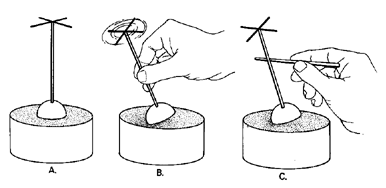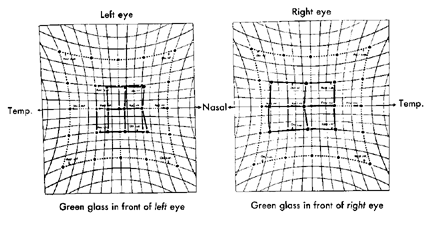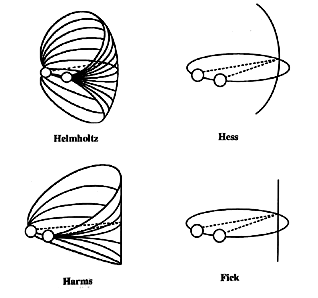[Previous Chapter] [Next Chapter]
[Table of Contents] [Home] [Glossary] [Video] [Help]
[Previous Chapter] [Next Chapter] |
Chapter 3 Key Words: degrees of freedom, references, tangent screen projection geometry, Cartesian coordinate systems, polar system, Donder's law, Listing's Law, false torsion, iso-vergence surface
Reference directions |
|
|
|||||||||||||
Clinically we have to describe the position of the eyes for a variety of reasons. We want to quantify eye turns, magnitude of abnormal nystagmus, monocular aiming errors of the eyes and phorias. This is all fairly easy if we describe pure vertical and horizontal movements but it becomes difficult if we have oblique movements. This is because there are several different ways that we could describe how the eye reached an oblique (tertiary) point starting from the primary position of gaze, e.g. we could describe eye position with a combination of vertical and horizontal rotation components or a single rotation about an oblique axis that was perpendicular to the plane containing the primary and tertiary eye position. Each of these approaches would result in a different torsion angle of the eye in the tertiary direction of gaze. Physiologically, the eye doesn't follow any of these coordinate systems. We only use these systems for our convenience to describe eye position with as few degrees of freedom as possible. Kinematics: Euclidian and Spherical Geometry: |
|
Clinically Applied Coordinate Systems: |
|
The horizontal path the eye takes while fixed in different amounts of elevation (isoelevation curves) and the vertical path the eye takes while fixed in different amounts of azimuth (isoazimuth curves) result in the classic clinical projection screens shown above. These screens are used to map the characteristics of ocular misalignment that vary with direction of gaze in cases of non-comitant strabismus. The five examples shown above (Fick, Helmholtz, Harms, Hess and Listing) are used when eye position is measured respectively with a major amblyoscope, a wall mounted projector, hand held Lancaster projectors, hand held prisms, and a perimeter. Ocular torsion about the visual axis is demonstrated by projecting the laser through a combination of vertical and horizontal Maddox cylinders mounted on the front of the sphere which produce an image of a cross on the projection screen. As the projector aims in different directions the projected image of the cross becomes distorted or scissored and torted (false torsion). The orientation of the projected cross can be used to illustrate the different amounts of torsion about the visual axis that result when various coordinate systems are used to point the eye into tertiary directions of gaze. The cross in the figures above show the actual torsion of the eye as descirbed by Listing. The orientation of the vertical and horizontal arms of the cross for the 4 Cartesian systems would follow the isoelevation and isoazimuth lines of the figure. The difference between the orientation of the Listing's cross and the grid represents false torsion. The direction of the visual axis can be described in spherical geometry as rotations about one or more axes. Optometry utilizes 5 different coordinate systems to describe direction of gaze and each coordinate system is made up of a unique set of axes to describe rotation. Normally we would need 6 degrees of freedom to describe the direction of gaze in 3-D space. Three degrees of freedom describe translation and three describe rotation. Because we keep the head stationary and the eye primarily rotates in the orbit, we only need the three rotational degrees of freedom. These are expressed as 3 axes of rotation that pass through the center of rotation and they rotate the eye horizontally, vertically and torsionally. Direction of gaze can be described by the amount of rotation about each of these axes. |
|
The coordinate systems described above are man made, i.e. they are for our convenience because they provide a way for us to quantify an eye position. They don't necessarily describe the actual movements of the eye needed to change direction of gaze, however one of the coordinate systems (Listings) has been used for this purpose. The various coordinate systems differ from one another in terms of whether the axes of rotation stay stationary with respect to the head or whether they move with the eye. Four of the systems are based upon Cartesian geometry and the fifth is based upon polar geometry. All of them have specific clinical applications for describing how projectors move targets in space to quantify eye position or visual fields. Head and Eye reference Axes of Rotation in Cartesian Coordinate Systems: |
|
|
|||||||||||||
The head itself is another example of a Fick coordinate system where the neck (vertical axis) remains fixed with respect to the body as the head elevates but the interaural axis (horizontal axis) moves as the head rotates about its vertical axis. This Fick coordinate system is use clinically to describe the positions of the two eyes measured with table mounted projectors such as the major amblyoscope. A similar system devised by Helmholtz uses a system of axes that are rotated 90 degrees relative to the Fick system. The Helmholtz system uses a head- or earth-referenced horizontal axis and eye- or projector-referenced vertical axis and it is used clinically to describe eye position with wall mounted projectors. |
|
|
|
||||||||||||
Listing's Plane |
 |
|||||||||||||||||
Fig 3.12 The figure above illustrates Listing coordinate system for movements of the eye restricted by an elastic membrane. Muscular ligaments that attach the eye to the orbit wall produce this membrane-like effect. |
|||||||||||||||||
Tangent Screen Projections: |
|||||||||||||||||
 |
|||||||||||||||||
Fig 3.13 Example of Hess chart used clinically to describe horizontal and vertical deviation measured with prisms. |
|||||||||||||||||
The amount of horizontal and vertical deviation measured with prisms is described by the Hess chart (shown above). If hand held flashlights are used in the Lancaster test then a Harms chart is used. The Lancaster test will require more vertical and horizontal displacement to quantify a tertiary direction of the eye than when prisms are used because the Hess screen is hyperbolic and the Harms screen is rectilinear. All four of the spherical cartesian coordinate systems described earlier result in different torsion values than those predicted by Listing's coordinate system. Therefore, an additional torsional adjustment is needed after making the vertical and horizontal rotations in order to have the same zero torsion as predicted by Listing's law. Because the eye obeys Listing's law and really doesn't need to make this additional adjustment, we call this torsion needed with man-made coordinate systems false torsion. Values of the false torsion needed for the Helmholtz system to conform to Listing's law and the real torsional posture of natural eye movements are given in Helmholtz's book on page 62. Another interpretation of false torsion is suggested by your text book Adler's Physiology of the Eye on page 108. This interpretation states that false torsion is any twisting or tilt of the vertical afterimage on the tangent screen away from true gravity referenced vertical. Under this system, the only coordinate systems that don't have false torsion are Fick and Harms. |
|||||||||||||||||
|
|||||||||||||||||
|
|||||||||||||||||
 |
|||||||||||||||||
Review Questions:
|
|||||||||||||||||
[Previous Chapter] [Next Chapter] |
|||||||||||||||||